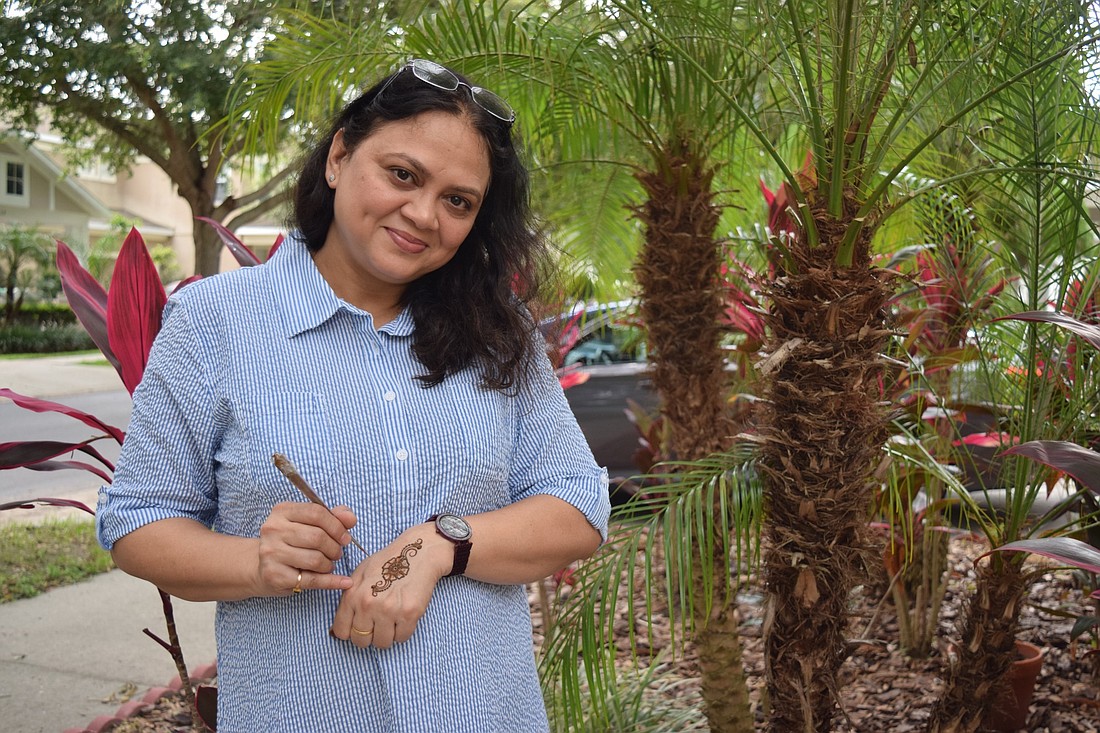- April 18, 2024
-
-
Loading

Loading

If someone woke Kesha Patel at 2 a.m. and asked her for a henna design, she wouldn’t be mad.
Instead, she would gladly mix up a henna cone and go to work on the blank canvas in front of her.
Like many artists, Patel is passionate about her craft and proud of her work. The Horizon West resident and henna artist has been creating henna since she was a little girl growing up in India.
Henna is a dye prepared from the plant Lawsonia inermis, a flowering plant that can be found in hot climates such as Pakistan, India and Australia. It contains lawsone, a reddish-orange dye that binds to the skin’s keratin and safely stains it — resulting in a temporary tattoo.
As a child, Patel and her friends plucked the leaves from the henna plant and created the dye themselves before going to work drawing out designs on one another.
“I loved to draw, that was my hobby when I was little,” she said. “I used to draw when I was in school. We had special subjects like drawing, and I did it very well, so that inspired me to do henna, too, when I get some cones of henna. … The color, when you see the color on your hand, it looks very nice. I love henna.”
Over the years, Patel’s practice has served her well. Her friends and family always come to her to have their henna done — whether it’s for special occasions or just for fun.
Patel gets her henna powders from India and mixes in essential oils to create the henna base. Then, she fills the plastic cones, like one would with frosting prior to icing a cake.
“I don’t use any dyes, no chemicals,” she said. “My henna is totally pure and natural. … (With) real tattoos, it’s for your whole life. But the henna is not forever — it’s like two weeks, and you can enjoy it for two weeks and you can do a different design every time. The other thing is it’s not painful.”
When she lived in India and wasn’t working, she passed time by doing henna on others for fun. After moving to the United States more than a decade ago so her sons could go to school here, her family members encouraged her to try doing henna for a living.
“I started doing it for people, and then people liked my work,” she said. “One of my friends when I was in India is a very well-known henna artist, so I learned from her also. I love henna, and when I came here, I started doing it for my living. I got phone calls from everywhere, and I travel everywhere for henna. My husband had me open my own website. Now I specialize for brides, and when I moved here, popular makeup artists called me and they wanted me to join with them.”
Her favorite type of henna to do is bridal patterns. In India, most brides get extensive henna patterns done on the hands and feet that go to the elbows and sometimes the knees. Guests might also receive smaller designs on the backs of their hands.
It could take from eight to nine hours for Patel to complete an intricate bridal pattern, but she never tires of it. In fact, she’s learning new henna techniques, such as portrait henna. She can take a passport-size photo, trace it on paper and then recreate the portrait on a client’s hand.
Although she’s only been in the Horizon West area since October, Patel already is starting to build up a clientele. However, COVID-19 threw a wrench in that progress earlier this year.
“I was working with some popular makeup artists, and then unfortunately this thing came up in March,” she said. “It’s very hard for everybody. And all the weddings got canceled. Still, I put it on NextDoor, and I get some little parties, like the girls get together and call me for henna.”
Designs can take anywhere from a few minutes to a few hours, depending on the size and intricacy of the pattern requested. Sometimes, Patel said, clients come in with a design they want, and she recreates it. Other times, they let her create her own artwork.
Creating henna for a living isn’t always easy — especially during a global pandemic that interrupted various special events people might request henna for — but it’s the love of the art and support of her family that keeps Patel going.
“My husband — he always supports me,” she said. “He has been very much by my side and … he always helps me a lot in this business because he knows that I love this. My kids always look out for me, and they also take care of me very well. With my husband and kids’ support, I’m able to do this. … I don’t feel like I’m working for my living. I enjoy doing it.”